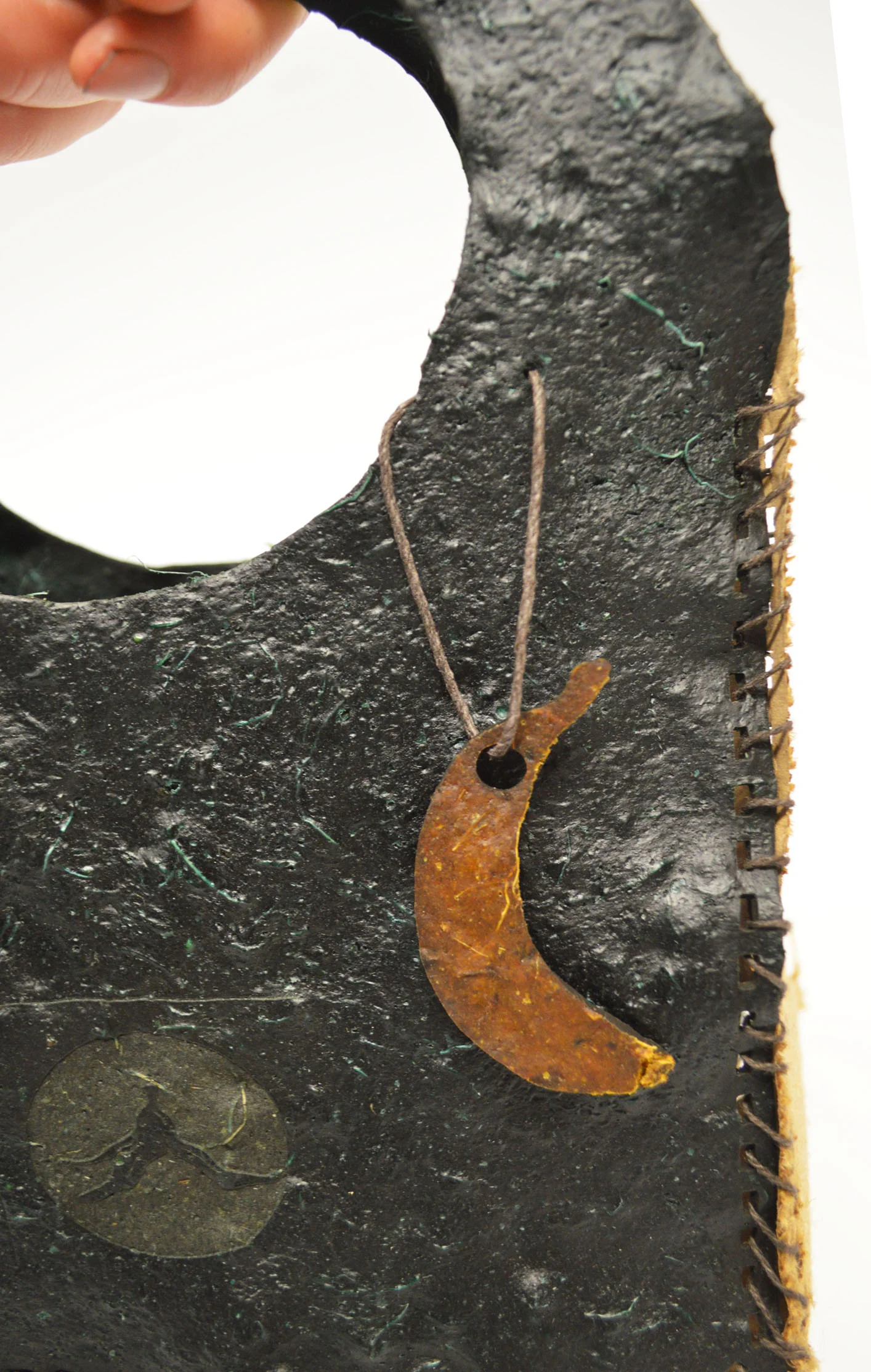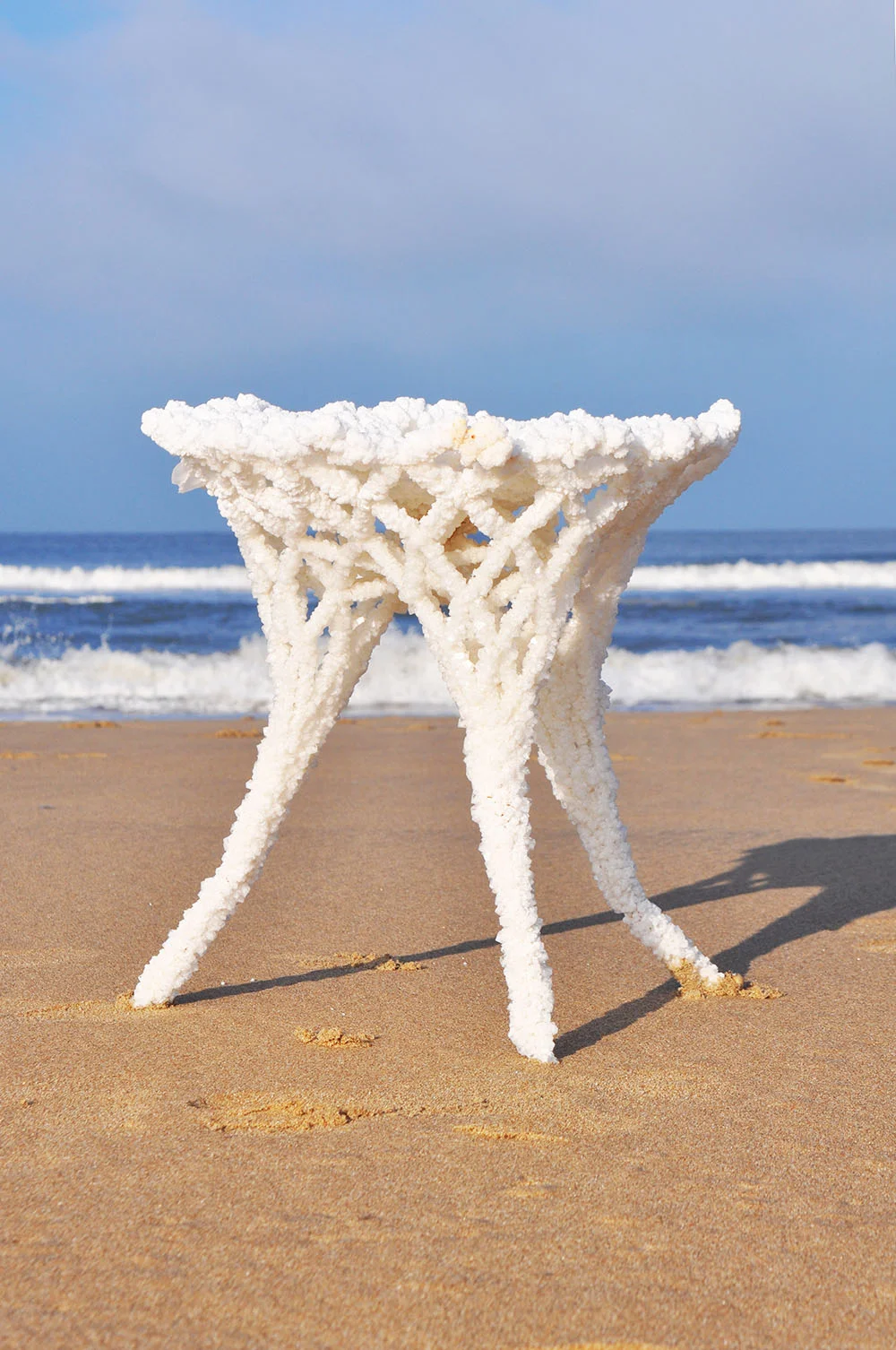Unlocking the aesthetic and functional potential within vegetable waste–The work of Angelique van der Valk
by Purva Chawla
An elegant, wafery square of material is in front of you.
Through its bright, unadulterated hues, translucent and glossy skin, speckled and fibrous patterns are visible.
Without understanding why, you have the sensation that this material is unquestionably natural, raw and unalloyed by industrial processing.
What is this material then, you wonder. What is it made of?
The gently-pressed composite material in your hands is a product of vegetable waste; the stalks, stumps, and peels of common vegetables are in here–broccoli, asparagus, cabbage, sweet potato, and parsnip among others–parts of whom you discard into the trash each day. This ‘vegetable waste’ has been dried and transformed into an aesthetically pleasing, preserved material by Dutch visual artist Angelique van der Valk.
While these swatches of Angelique’s vegetable-based material immediately open your eyes to the aesthetic and functional potential within discarded, organic bits, it is not the only format that her work takes, nor is it her only exploration of vegetables as a tool for art. In fact, she often combines macro photography of vegetables, and starch-based natural paint with this pressed vegetable material, creating high-contrast and abstract compositions.
From the 'Vegetables and Abstract' (Groenteabstracten) series by Angelique van der Valk
In all of these works though, the primary intent is to reveal the possibilities within vegetable waste–the forms, textures, fibrous structure and hues–both as an inspiration for shapes and prints in other mediums, as well as a raw material in itself, for art and design.
Also crucial to Angelique’s practice, is creating materials and artwork that are Cradle-to-Cradle in their existence. The material she creates–pressed ( and therefore naturally glued together) combinations of dried and varied vegetables– is biodegradable and can return to the earth with ease. This is a feat, considering biodegradability is not every artist’s chief concern even today, especially when creating gallery-worthy panels of art. Angelique achieves this and explores multiple formats of doing so.
All parts of Red Cabbage, after its harvest, being employed by Angelique van der Valk as part of an installation
On the one hand, Angelique's vegetable-based material can exist as stand-alone paper or veneer, and most recently was integrated into textiles by her. On the other hand, she enjoys creating inter-medium crossovers, by bringing the vegetable waste-paper, photographs, and paintings (of Casein paint, sand, Hemp, and Endocarp) next to one another, combining different techniques in one piece of work–an act that gives her a whole new language to work with. She says “In my work, a penchant for abstraction is visible, combined with the beauty of this natural material. The tension between abstraction on one side and the organic forms of this material, on the other hand, is what I find most interesting. It reflects, to my mind, the way we live: culture, on one side, nature on the other. I strive for harmony between these two, or to make their tension and friction visible.”
From the 'Organic and Abstract' series by Angelique van der Valk, Vegetable print on wood combined with starch-based paint
Recently, MaterialDriven spoke with Angelique, to understand her motivations for working with vegetable waste, as well as her current process; but also to question what lies ahead for her and where she sees her vegetable-based material being used.
MD: Angelique, your work is inspired by Cradle to Cradle thinking; What about this movement and approach has drawn you to it?
Angelique: In 2014, before my graduation from a program in visual arts and teaching, Michael Braungart and William McDonough (the authors of 'Cradle to Cradle') made me conscious of my own production processes and results. After reading the book Cradle to Cradle [Remaking the Way We Make Things], I became aware of this thinking, and it instantly gave me a clear focus for that final year.
'Art is food' became my overriding theme that year. For me, it translated to Food for thought, for awareness, for the eyes (aesthetically), and most importantly for the environment–after being used, my work could then become food for the earth. At the time I didn't know where this approach would lead me; I was stepping into an unknown world, and it is still an ongoing process for me, even today.
MD: What led you to work with biodegradable materials, and vegetables in particular?
Angelique: I started out by mapping all incoming products for my home, their uses and finally the waste exiting my household. I questioned–when buying and using sustainable products, how sustainable is it to use only certain parts of products, rather than all parts of them? I selected some of this waste (the parts not being used) and tried to fracture, dry, combine and glue different kinds together.
Red Cabbage that is too small to be sold at grocery stores is among the biodegradable vegetable wastes employed by Angelique van der Valk.
At one point, a thought popped into my head– the fact that we are the only animals not eating the peels, skins, and stumps of our vegetables, throwing most of it away like trash. The vegetables I started experimenting with came from my grocery bag, the season’s organically produced vegetables from local farmers. I began to use the upper parts, peels, skins, and stumps of these vegetables–letting them dry, binding and gluing them together–and creating results that were initially quite strange to see.
MD: What are the general physical processes you employ, to turn this 'waste' into the preserved and aesthetically finished results we see?
Angelique: The main process I employ is an ancient one: before paper was invented, people made material out of plant fibers, to write on. The natural cellulose of this vegetable material allows me to glue pieces together when under pressure. These nerves and fibers show up when the pieces are almost dry. Other materials I use are Hemp, Endocarp, and paint made with starch as a binder and natural earthen colors as pigments, as well as sand for a rough, textured contrast.
Natural cellulose in vegetable material allows Angelique van der Valk to glue pieces together when under pressure. Seen here are pieces from her 'Vegetables and Abstract' (Groenteabstracten) series.
MD: Which materials and their combinations are you working with just now?
Angelique: Vegetable peels and skins pressed onto textile are a new combination for me, and I am experimenting with taking this further right now, as well as searching for applications and ways of combining it with visual art. I have found that the organic forms within the vegetable material and harsh lines (used as a metaphor for human interference) work very well together visually. Combining organic forms and lines makes a harmonious whole–an idea that can be developed further for me as well.
Combining vegetable peels and textile: Asparagus and Parsnip peels on unbleached canvas, by Angelique van der Valk
MD: Where would you like to see your work go? Is there a functional product you would like to create in the future?
Angelique: Not being a product designer myself, I would like to work with others in the field of design to see if the detailed photographs of vegetable waste can be used as prints in interior design, textile design or pattern making. I sense that the aesthetic and visual quality of the dried vegetable waste is new to our fields, and can be an inspiration, or material to work with for other artists. I’m also curious, above all, to see if the physical material itself, the vegetable waste, dried and pressed, flat or in any form can be integrated into a sustainable and useful product.
Angelique van der Valk used Casein paint combined with other materials such sand, hemp, wood dust and endocarp for her Abstract in Earth Colors series.
MD: 'Groenteabstracten' has been a continuing project for you. Do tell us about it.
Angelique: Groenteabstracten –The vegetable and abstract series has been fun for me, they are very tiny pieces of work, each one complete and beautiful in itself. They give me the opportunity to try to combine different peels, skins, and stumps and learn the difference in structure and detail between them. I do want to extend this to a larger format physically. Working with a larger press means that results, opportunities, and possibilities with these pressed, combined materials can be extended.
Angelique van der Valk experiments with drying and transforming the roots of Purple Cabbage.
MD: Finally, are there others in the field of art, design, or research whose work inspires your investigations?
Angelique: What inspires me the most are colleagues who are designing not only a product but an entire sustainable production process from beginning to end. A vast interest in material, textile, and product design, and also in minimal abstract art makes it impossible for me to name just one source. It’s the stream of techniques and designs seen on different platforms offline and online, like yours that continuously keeps me up to date and inspired.















